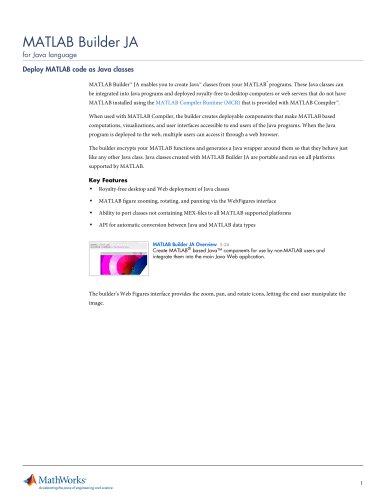
Catalog excerpts

SimDriveline Model and simulate one-dimensional mechanical systems SimDriveline™ provides component libraries for modeling and simulating one-dimensional mechanical systems. It includes models of rotational and translational components, such as worm gears, planetary gears, lead screws, and clutches. You can use these components to model the transmission of mechanical power in helicopter drivetrains, industrial machinery, vehicle powertrains, and other applications. Automotive components, such as engines, tires, transmissions, and torque converters, are also included. SimDriveline models can be converted into C code for real-time testing of controller hardware. Learn more about physical modeling. Key Features ▪ Common gear configuration models, including planetary, differential, and worm gears with meshing and viscous losses ▪ Clutch models, including cone, disk friction, unidirectional, and dog clutch ▪ Vehicle component models, including engine, tire, torque converter, and vehicle dynamics models ▪ Models of translational elements, including leadscrew, rack and pinion, and translational friction ▪ Ideal and nonideal model variants, enabling adjustment of model fidelity ▪ Ability to extend component libraries using the Simscape language ▪ Ability to specify units for parameters and variables, with automatic unit conversion ▪ Support for C-code generation from SimDriveline models (with Simulink Coder™) Modeling a Vehicle Powertrain 4:28 Model a vehicle powertrain, including gears, tires, engine, and longitudinal vehicle dynamics. You can use SimDriveline to optimize system-level performance and to create plant models for control design. The models you create support your entire development process, including hardware-in-the-loop simulations.
Open the catalog to page 1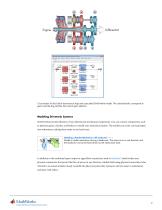
*j sdl.dual.crutch,Irani/Dual clutch transmixuctVEven geara Eilc £dit Miew JJuplay Diagram Simulalron £ralytu Lode Tools Help Cross-section of dual clutch transmission (top) and associated SimDriveline model. The colored blocks correspond to gears and the dog clutches that control gear selection. Modeling Drivetrain Systems SimDriveline provides libraries of one-dimensional mechanical components. You can connect components, such as planetary gears, clutches, and brakes, to model your mechanical system. The models you create can be grouped into subsystems, making them easier to read and...
Open the catalog to page 2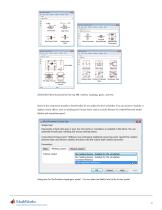
file gdit yjie* Eiipiay dagcam ftnaiyju Jieip Cone Clutch Dog Clutch Disk Friction Clutch Unidirectional file Edit yiew cupiay Di«gr.am fijviynt Help Torque Converter Sprifig-Damper Va/iable Ratio "j Library: Tirei.Vctiklti Lu jd^l File Frii: View Ofplfly Diagram Anatysij Help Vehicle Body Interaction (Magic File Edit View DupHy Diagram Analyw Planetary Gear Compound Planetary Ravignaaux Gear SimDriveline libraries (clockwise from top left): clutches, couplings, gears, and tires. Many of the component models in SimDriveline let you adjust the level of fidelity. You can choose to include or...
Open the catalog to page 3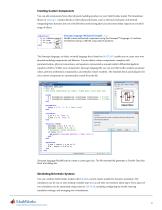
Creating Custom Components You can add components from other physical modeling products to your SimDriveline model. The foundation library in Simscape™ contains blocks in other physical domains, such as electrical, hydraulic, and thermal. Integrating these domains into your SimDriveline model using physical connections helps expand your model's equations 1 Simscape Language: Mechanical Example 3:42 k == tablelookup (> Model custom mechanical components using the Simscape™ language. A nonlinear translational spring is defined using implicit equations. The Simscape language, an...
Open the catalog to page 4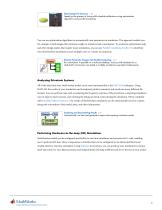
Maximizing Fuel Economy 1:48 Speed up the process of tuning shift schedule calibrations using optimization algorithms and parallel computing. You can use optimization algorithms to automatically tune parameters in simulation. This approach enables you, for example, to find designs that minimize weight or minimize fuel consumption. To accelerate optimization tasks and other design studies that require many simulations, you can use Parallel Computing Toolbox™ to distribute your SimDriveline simulations across multiple cores or a cluster of computers. Shorten Parameter Sweeps with Parallel...
Open the catalog to page 5
^ Independent Fixed-Step Solver Stiff Fixed-Step Solver ratkj&lcsses Side ahate Solver configuration for dual-clutch transmission model. A stiff fixed-step solver is used for the physical system (shaded pink) and an independent fixed-step solver is used for the rest the model (shaded blue). You can generate C code from your SimDriveline models using Simulink Coder. The generated code can be used to run HIL simulations on real-time processors that interface directly with hardware. This enables you to test your control algorithms without relying on hardware prototypes. 1 Simulating In Real...
Open the catalog to page 6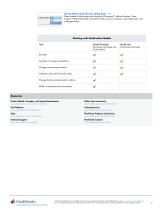
Sharing Models Using Simscape Editing Mode 3:32 Share models without requiring licenses for Simscape™ add-on libraries. Open models in Restricted Mode and perform tasks such as simulation, parameter tests, and code generation. Working with SimDriveline Models Task Model Developer (Purchases Simscape and SimDriveline) Model User (Purchases Simscape) Simulate Log data or change visualization Change numerical parameters Generate code with Simulink Coder Change block parameterization options Make or break physical connections Resources Product Details, Examples, and System Requirements...
Open the catalog to page 7All The MathWorks catalogs and technical brochures
-
MATLAB Production Server
6 Pages
-
Database Toolbox
4 Pages
-
MATLAB Report Generator
4 Pages
-
Stateflow
8 Pages
-
SimEvents
7 Pages
-
SimHydraulics
7 Pages
-
SimPowerSystems
8 Pages
-
Simulink Control Design
5 Pages
-
Aerospace Blockset
5 Pages
-
SimRF
6 Pages
-
Simulink Coder
6 Pages
-
Embedded Coder
8 Pages
-
Simulink PLC Coder
4 Pages
-
Fixed-Point Designer
9 Pages
-
MATLAB Coder
5 Pages
-
Simulink 3D Animation
10 Pages
-
Gauges Blockset
2 Pages
-
Simulink Report Generator
3 Pages
-
Polyspace Bug Finder
6 Pages
-
global-optimization-toolbox
10 Pages
-
Phased Array System Toolbox
9 Pages
-
OPC Toolbox
5 Pages
-
Simulink Design Verifier
7 Pages
-
Simulink Design Optimization
10 Pages
-
Filter Design HDL Coder
5 Pages
-
Bioinformatics Toolbox
9 Pages
-
SimBiology
6 Pages
-
Computer Vision System Toolbox
10 Pages
-
DSP System Toolbox
11 Pages
-
Fuzzy Logic Toolbox
5 Pages
-
Polyspace Client for C/C++
5 Pages
-
xPC Target
5 Pages
-
SimMechanics
7 Pages
-
Simscape
7 Pages
-
Simulink
6 Pages
-
Data Acquisition Toolbox
8 Pages
-
Image Processing Toolbox
7 Pages
-
Signal Processing Toolbox
10 Pages
-
Control System Toolbox
6 Pages
-
Symbolic Math Toolbox?
6 Pages
-
Parallel Computing Toolbox?
7 Pages
-
MATLAB®
6 Pages
-
Mapping Toolbox 3.2
7 Pages
-
Instrument Control Toolbox
7 Pages
-
Optimization Toolbox 6.0
14 Pages
Archived catalogs
-
MATLAB Release Notes
505 Pages
-
C and Fortran API Reference
263 Pages
-
External Interfaces
649 Pages
-
Function Reference: Volume 3 (P-Z)
1696 Pages
-
Function Reference: Volume 2 (F-O)
1568 Pages
-
Function Reference: Volume 1 (A-E)
1298 Pages
-
Creating Graphical User Interfaces
520 Pages
-
3-D Visualization
212 Pages
-
Graphics
667 Pages
-
MATLAB Programming Tips
66 Pages
-
Programming Fundamentals
840 Pages
-
Data Analysis
220 Pages
-
Mathematics
316 Pages
-
MATLAB® Getting Started Guide
250 Pages



